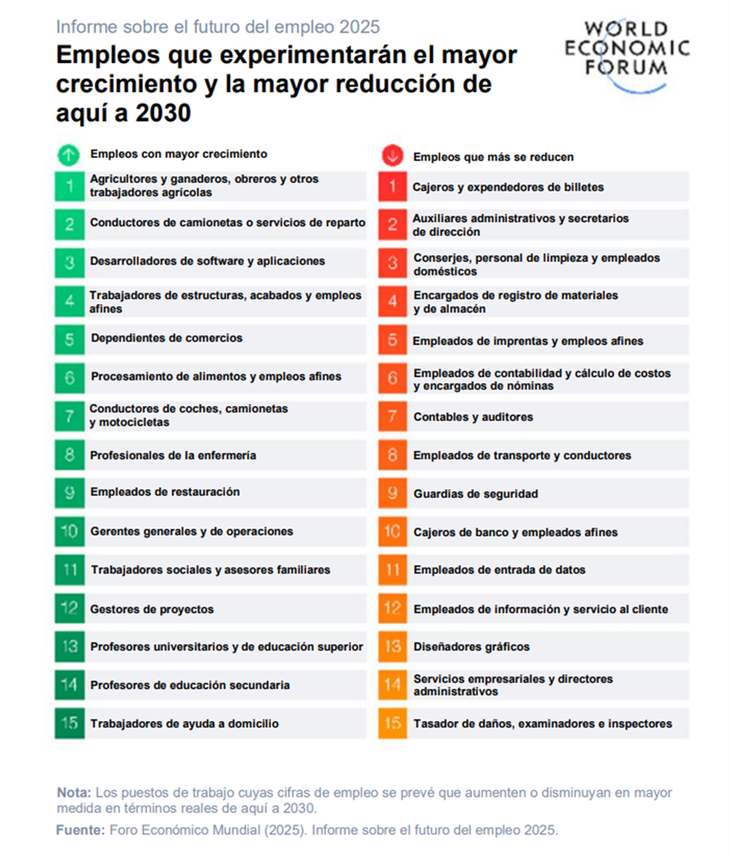Demand
It is expected a rapid increase in demand for technological capabilities in artificial intelligence (AI), big data and cybersecurity, but it is also pointed out that human abilities, such as Creative thinking, resilience, flexibility and agility will continue to be capital. A combination of both types of skills is expected to become increasingly relevant in a rapidly evolving labor market.
image.png
Despite technological innovations, certain skills such as creative thinking, resilience, flexibility and agility will continue to be sought after by companies.
World Economic Forum
Frontline jobs and essential sectors, such as caregiving and education, will see the highest employment growth between now and 2030. Likewise, advances in AI and renewable energy are redefining the market by increase the demand for technology professionals or specialists and induce a lower need for other workers, such as graphic designers.
“Trends like “Generative AI and rapid technological changes are transforming sectors and labor markets, creating unprecedented opportunities but also serious risks,” assures Till Leopoldresponsible for Work, Wages and Job Creation at the World Economic Forum.
And adds: “It’s time for you businesses and governments work together, invest in skills and create a global workforce resilient and egalitarian”.
Winners and losers
The World Economic Forum predicts that, Between now and 2030, the greatest employment growth in absolute terms will occur among frontline workers, such as farmers and ranchers, delivery drivers, and construction employees.
image.png

Agriculture, livestock, delivery and construction sectors will show the most growth.
World Economic Forum
It is also expected a strong increase in jobs related to care, such as nursing professionals, as well as in the field of education, such as secondary school teachersin a context in which demographic trends drive greater demand in essential sectors.
Likewise, he predicts that advances in AI, robotics and energy systems —especially in renewable energy and environmental engineering— increase the demand for specialized positions in these areas.
On the other hand, jobs like those of Cashiers and administrative assistants continue to be among those who decline the fastest, to which are now added professions such as graphic design, due to the rapid transformation of the labor market that AI is causing.
Qualifications
It is considered that The skills gap continues to be the main obstacle to achieving business transformation in response to global macro trends. 63% of employers cite this gap as the most important barrier to adapting its operations to future situations.
If the global workforce were represented by a group of 100 people, 59 would need to upgrade or retrain their skills by 2030, something from which 11 would probably not benefit, supports the report. This translates into more than 120 million workers at risk of dismissal in the medium term.
Artificial intelligence
AI is redefining business models. The study states that almost half of employers worldwide plan to reorient their businesses to take advantage of new opportunities arising from technology.
It is expected that, in terms of the workforce, the most common response to these changes will be upskilling workers, as 77% of employers plan to do so.
However, 41% of them plan to reduce their workforce as a result of automating certain tasks through AI. Nearly half of employers plan to move employees in jobs exposed to AI disruption to other areas of their companies, providing an opportunity to close skills gaps while reducing the human cost of technological transformation.
The report highlights that, given the rapid growth of emerging technologies, business leaders, policymakers and workers will need to work together to ensure that the workforce is prepared and, in turn, reduce unemployment risks in different sectors and regions.
Another factor driving change in the labor market is the rising cost of living, and half of employers expect this factor to transform their business models. Although global inflation has fallen, Price pressures and slowing economic growth are expected to displace 6 million jobs worldwide by 2030. These challenges mean that skills in resilience, agility, flexibility and creative thinking are increasingly in demand.
Demographic changes are also redefining labor markets. An aging population, especially in higher-income countries, increases demand for healthcare jobs, and the increase in working-age populations in lower-income regions drives growth in education-related professions.
Besides, Geopolitical tensions are a major concern for 34% of companies, and trade restrictions and changes in industrial policies cause the transformation of many others. This means that some companies plan to adapt through offshoring and relocation strategies. These pressures are also increasing demand for qualifications such as cybersecurity.
The report warns that addressing the enormous changes that are coming demand urgent and collective measures by governments, companies and the educational sector. Among the main priorities are close the skills gap, invest in upskilling and reskilling initiativesas well as creating accessible itineraries to access the fast-growing jobs and the most in-demand skills.
Source: Ambito
I am an author and journalist who has worked in the entertainment industry for over a decade. I currently work as a news editor at a major news website, and my focus is on covering the latest trends in entertainment. I also write occasional pieces for other outlets, and have authored two books about the entertainment industry.




